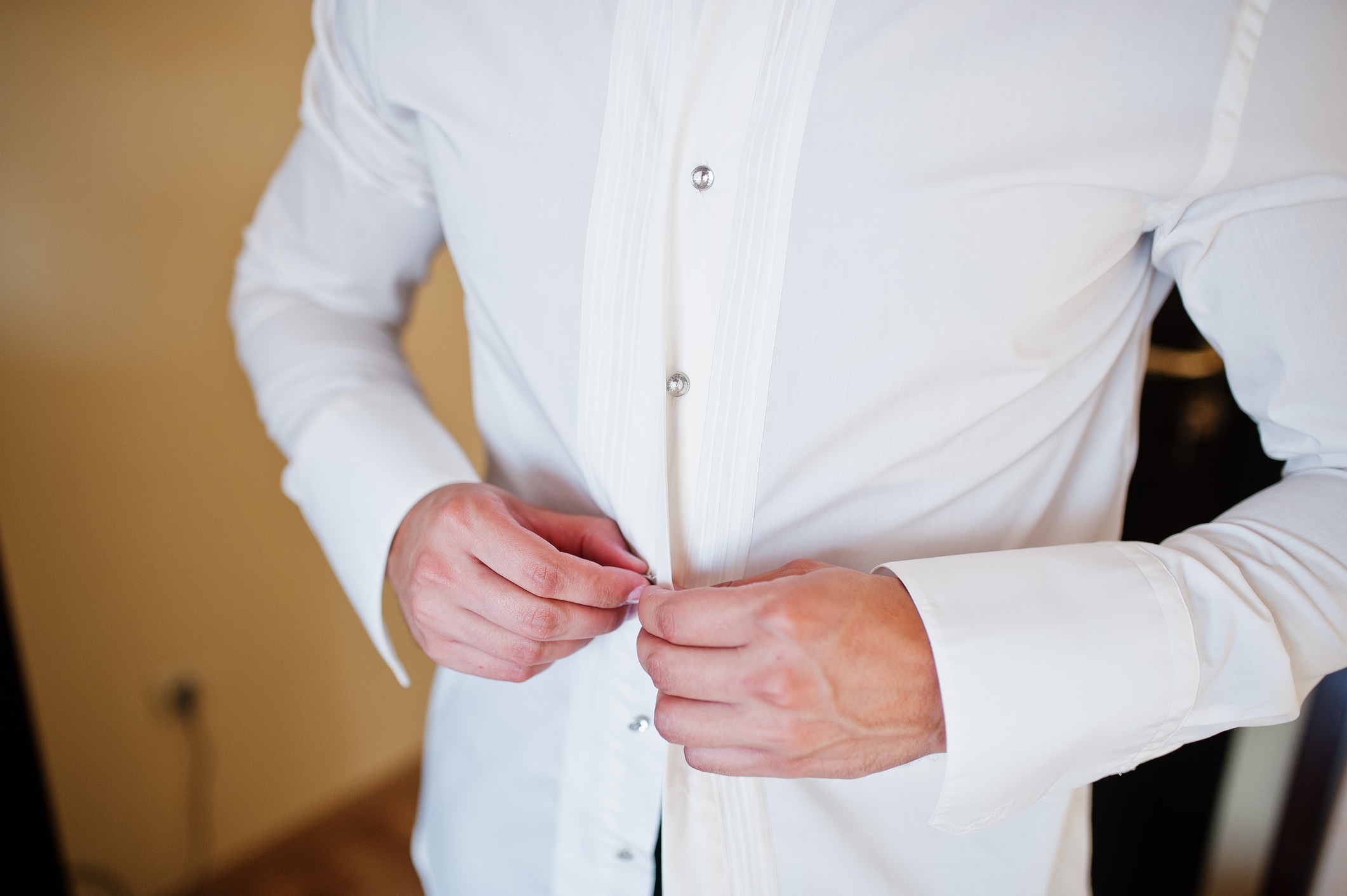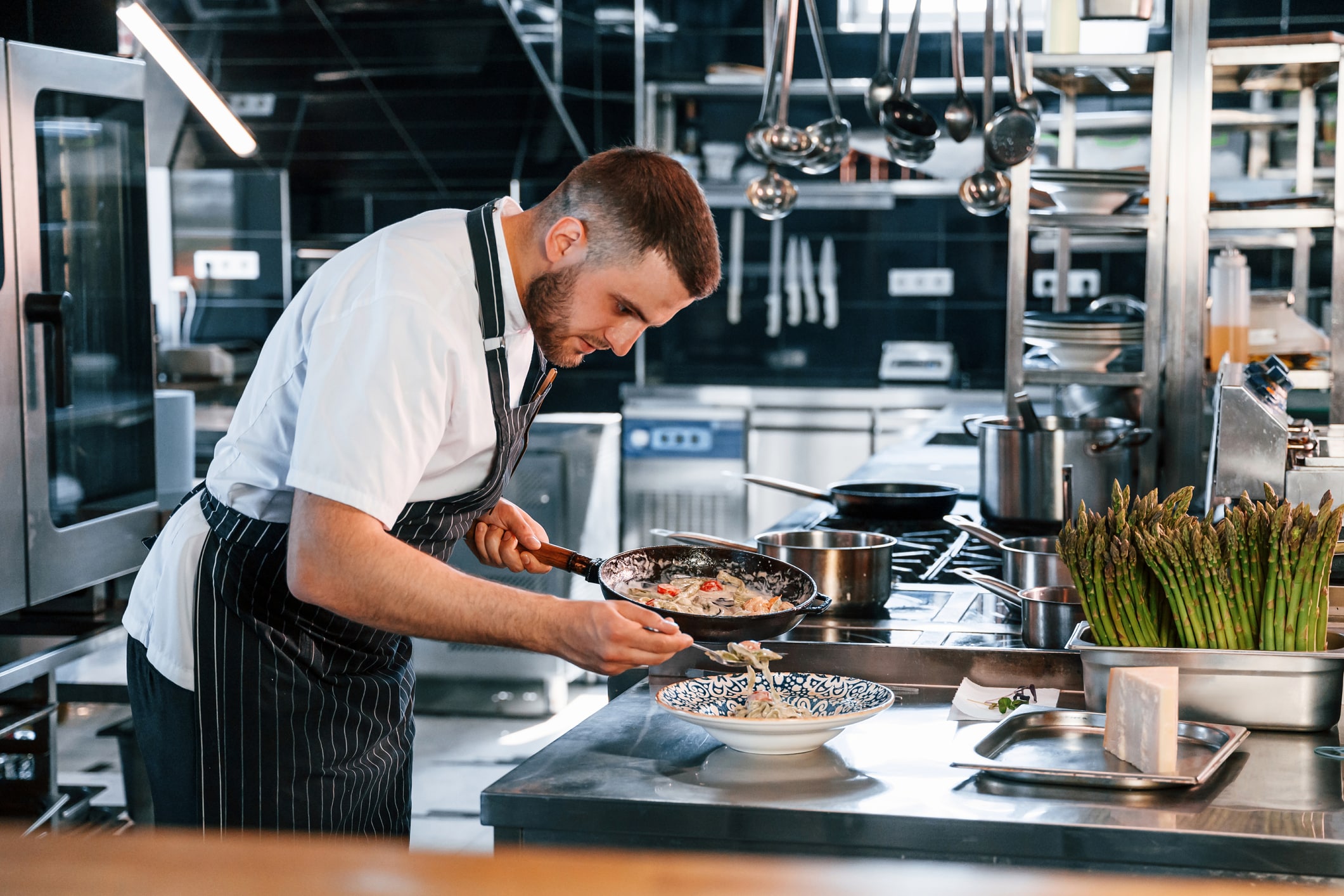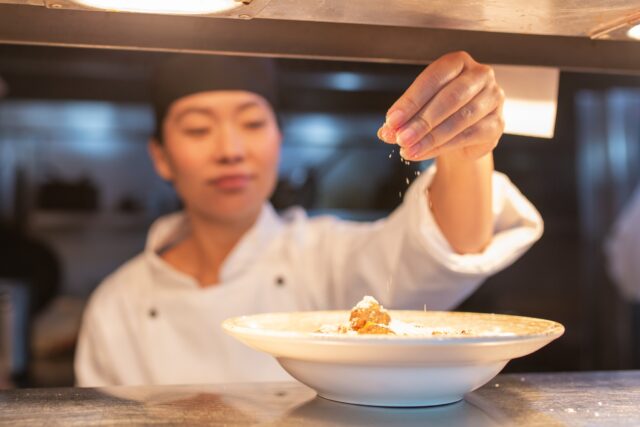
In the dynamic and highly competitive world of the hospitality industry, every detail matters. One of the most visually impactful aspects that can shape a guest’s experience, and an employer’s impression of you, is the uniform you wear. Hospitality workwear goes beyond aesthetics; it represents the employer’s brand identity, and creates a sense of cohesion among the team – contributing to a memorable customer experience.
Whether you work in hospitality here and now or manage catering services for your employer on a regular basis, this comprehensive guide will help you to master the art of how you should dress as a hospitality professional in the industry. By adhering to these standards, you can ensure that your appearance not only aligns seamlessly with your employer’s vision, but also leaves a lasting positive impression on your guests – meaning you’ll be invited back time and again. In this guide, we’ll highlight the tips for choosing the perfect hospitality uniform, uniform care instructions, and the do’s and don’ts when it comes to hospitality uniforms. You can then consider the right hospitality roles for you.
Tips for choosing the perfect hospitality uniform
What your uniform says
Uniforms are more than just what you wear; they’re a visual representation of your employer’s/venue’s values and ethos. They communicate professionalism, consistency, and a sense of belonging among the staff. In an industry where guest satisfaction is of paramount importance, hospitality workwear plays a vital role in shaping guest perceptions. A well put together uniform has the potential to elevate the overall guest experience, making it a crucial aspect of your establishment’s success.
Essential considerations for crafting the perfect uniform
- Reflecting the employer’s identity: your uniform should serve as a visible representation of your employer’s personality. Whether your establishment exudes classic elegance, modern sophistication, or quirky charm, the uniform’s design, colors, and style should echo that sentiment.
- Prioritizing comfort alongside functionality: in an industry that demands long hours and a range of tasks, comfort and practicality are of equal importance in reflecting your employer’s identity. When choosing your hospitality workwear clothing, opt for fabrics that allow for ease of movement and are suited to your specific roles and responsibilities.
- Durability: hospitality uniforms endure daily wear and tear, along with regular washing. Invest in high-quality hospitality clothing that can withstand the demands of frequent use, while retaining their appearance.
- Harnessing color psychology: Colors can have psychological influences on the emotions and perceptions of both guests and employers. Conduct research into color psychology to choose those that evoke the desired feelings in both your guests and fellow employees. It’s highly likely that darker hues – black and navy – come out on top.
- Blending in with the background: The ambiance and setting of your establishment should inform your uniform choices. In terms of hospitality uniform, a fine-dining restaurant might call for formal attire, while a casual café might warrant a more relaxed and approachable uniform.
That’s great, but what clothes should I actually wear?
- If you’re front of house or waiting staff: Whether you’re waiting staff at a restaurant or large-scale banqueting suite, or bartending at a gallery opening night, it’s highly likely you’ll be asked to wear either a men’s/women’s white or men’s/women’s black shirt. This is essential if you’re going to directly interact with guests, and exudes a sense of professionalism and elegance. You don’t need to spend a fortune on these items. If you’re thinking where to get them, Stock Mfg is a good place to start.
- A pair of smart, black trousers is another ‘must have’: Again, these don’t need to be expensive – similar to the shirts – as long as they fit well and you keep them in good condition. Men’s and women’s trousers will, of course, vary slightly in style; just be sure to avoid flares, denim, chinos, and patterned designs.
- When it comes to footwear…:Go for a smart, black, leather pair of men’s/women’s shoes. But, it’s just as important that they’re comfortable as well as smart, as you’ll often be walking or standing for many hours on shift – so make sure they fit well.
- For housekeeping roles: Housekeeping staff require uniforms that are both durable and comfortable, so go for practical clothing such as tunics or shirts, paired with comfortable, non-slip shoes.
- If you’re working back of house/as a cook: Simply put, you can’t hold down a kitchen unless you have food service clothing or proper working clothes. By this, we mean you need to own a set of men’s/women’s chef whites, as well as an apron and some non-slip footwear. These need to be comfortable, but take safety into consideration too. Maintaining a safe and hygienic working environment is essential in any kitchen.
Little personal touches
- Name badges: Sometimes, with your hospitality uniform, it’s the little touches that count. Wearing a name badge not only helps guests to identify you as a member of staff, it also adds a personal touch to guest interactions – allowing you to build a rapport with them.
- Embroidery and logos: One step up from wearing a name badge, embroidering staff names or logos onto uniforms enhances brand visibility and contributes to a more professional appearance, nurturing the sense of unity among you and your colleagues.
- Accessories: It may be worth considering accessorizing your uniform, with items like scarves, ties, tie pins, or brooches, to inject a touch of personality into your uniform, while also maintaining an overall sense of formality.
Hospitality uniform care instructions
 Keeping up appearances in the hospitality sector Proper care of hospitality sector workwear is essential to maintain a professional appearance and ensure your uniforms last that little bit longer. Here are some top tips for uniform care instructions:
Keeping up appearances in the hospitality sector Proper care of hospitality sector workwear is essential to maintain a professional appearance and ensure your uniforms last that little bit longer. Here are some top tips for uniform care instructions:
- Read the labels: Always follow the care instructions provided on the label of each item of clothing. These labels provide valuable information about washing (including whether clothing should be dry cleaned), drying, and ironing, specific to each fabric.
- Separate colors: Separate uniforms by color before washing. Dark colors should be washed together, and light colors should be washed separately to prevent color bleeding. After all, you don’t want to end up with gray shirts!
- Pre-treat stains: Treat stains promptly before washing. Use a proper stain remover, like Shout or Spray ‘n Wash, or certain methods based on the type of stain (grease, wine, tomato sauce, etc.). Avoid using harsh chemicals that might damage the fabric.
- Gentle washing: Use a gentle wash cycle with cold water for most hospitality uniforms. This helps prevent fabric damage and color fading. Consider using a mild detergent that’s suitable for the specific fabric your hospitality uniform is made from.
- Fasten buttons and zippers: Before washing, fasten buttons, zippers, and hooks to prevent them from snagging on other items of clothing – the last thing you want is a tear in your pristine uniform.
- Avoid bleach: Using bleach on uniforms can weaken the fabric and cause discoloration over time – giving your uniform(s) a faded look. Search for color-safe alternatives to bleach where possible.
- Delicate Fabrics: If uniforms are made from delicate fabrics such as silk or satin, place them inside a mesh laundry bag to prevent damage from friction with other clothing items.
- Drying your uniform carefully: Air-drying is generally the best option for hospitality uniforms. If you have an outside clothesline, and it’s a dry, sunny day, hang your clothes out on that line. If using a dryer indoors, instead, use the lowest heat setting to avoid shrinkage, fabric damage, and color fading.
- Ironing guidelines: Follow the ironing recommendations on clothing labels. Use the appropriate heat setting based on the fabric type (cotton, wool, polyester, etc). For fabrics that require special care, use a pressing cloth to prevent direct contact between the iron and the fabric.
- Storage: Store your hospitality uniforms in a cool, dry place, away from direct sunlight, to prevent color fading and fabric deterioration. Use padded hangers for items like blouses and shirts to help maintain their shape.
- Rotating your uniforms: If you can, try to rotate between several sets of uniforms. This allows each uniform to have ample time to rest between wears and washes, minimizing wear and tear.
- Regularly inspect your uniforms: Conduct regular inspections of uniforms to identify any wear and tear, loose threads, or missing buttons. Promptly repair or replace damaged items to maintain your professional appearance at each event you attend.
By following the guidelines above, you’ll ensure your hospitality workwear is always in tip-top condition, so you always shine on every shift and make a positive impression on both guests and your employer.
Do’s and Don’ts of Hospitality Uniforms
 The do’s
The do’s
- Professionalism: Choose uniforms that reflect the level of professionalism and the quality of service your establishment offers. A well-designed uniform can enhance your overall image, and that of the business, and help ensure they hire you again.
- Comfort: Prioritize comfort when selecting uniforms. You’ll be wearing these uniforms for long periods of time, so ensure they are made from breathable, comfortable materials and offer a good fit.
- Functionality: Consider the practicality of the uniforms you select. For example, do they have enough pockets for essential items like notepads and pens? Are your shoes comfortable and slip-resistant?
- Variety: If possible, make sure you have a variety of uniform options available, for different roles and seasons. For example, front-of-house staff might have different uniforms than kitchen staff. Having a range of hospitality uniforms allows you to meet specific job requirements.
The Don’ts
- Designs that draw attention: Avoid overly loud, brash, or flashy designs that could be considered distracting, and may detract from the professionalism of the establishment in which you’re working. Keep designs simple and aligned with your employer’s brand identity.
- Uncomfortable fabrics: Stay away from fabrics that are uncomfortable or those which could cause irritation. Scratchy or itchy materials will put you in discomfort throughout your shift and may impact your performance.
- Ill-fitting clothing: Hospitality uniforms that are too tight, too loose, or poorly tailored can also lead to discomfort. Ensure that your uniform fits well.
- Excessive accessories: While accessories can add style, avoid going overboard. Too many accessories can potentially be a safety hazard in a hospitality setting. Avoid wearing lots of jewelry, if possible.
- Inappropriate messages: It kind of goes without saying, but we’ll say it anyway – avoid uniforms with offensive or inappropriate messages, images, or slogans on them.
- Ignoring feedback: Don’t dismiss feedback from your employer regarding your uniform – particularly in relation to functionality or appearance. Their insights can help you make informed decisions about your uniform choices, and help ensure you work for them again.
Remember, hospitality uniforms not only represent the employer/venue you’re working for; they also have an impact on the way in which you present yourself, your levels of confidence and, ultimately, your performance. Striking the right balance between functionality, comfort, and style will contribute to a positive experience for both you and the guests you’re serving.
Nailing your hospitality uniform
Hospitality uniforms go beyond everyday clothing; they encapsulate your establishment’s identity and contribute to unforgettable guest experiences. By carefully considering design, functionality, comfort, safety, and role-specific requirements, you can excel in the hospitality sector, exceed guest expectations, and impress your employer. A well-crafted uniform not only helps you to look professional, it also boosts your confidence, and helps build unity among the team you’re working with. Consider the information and advice set out in these guidelines, to help ensure that your hospitality uniforms set the stage for exceptional guest experiences and lead to ongoing career success for yourself.
Download the Indeed Flex app today and choose from a number of exciting roles covering the whole of the vibrant hospitality sector.








